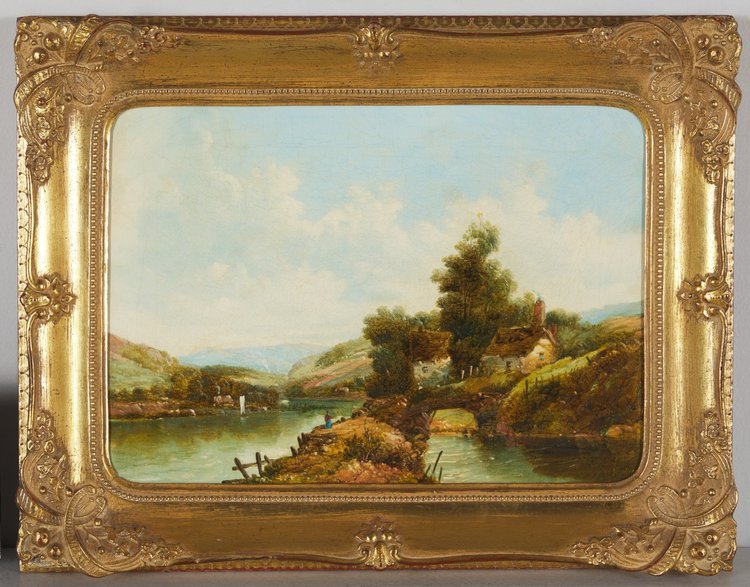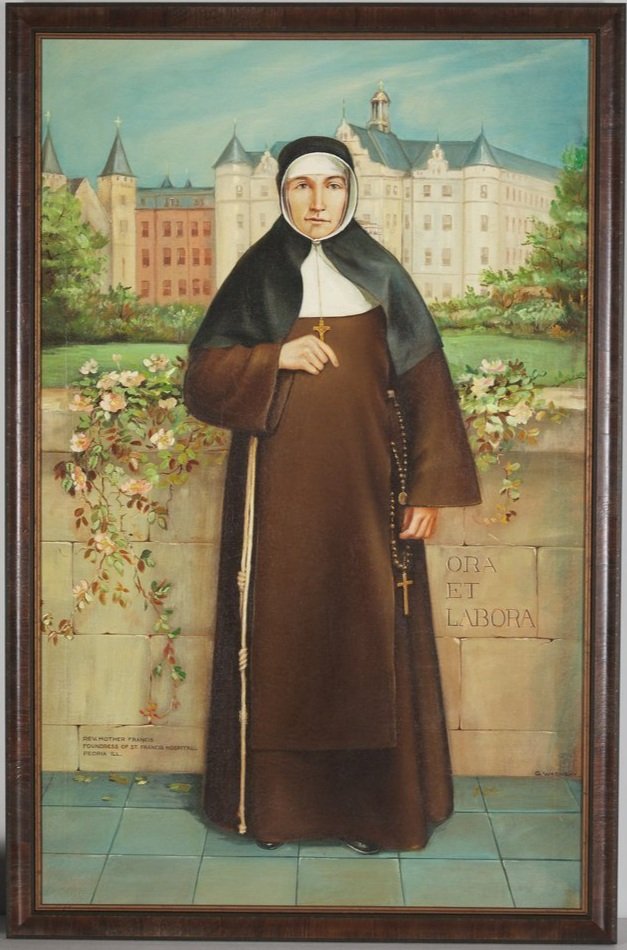When After the Ball, a painting depicting Cinderella’s hurried exit from the ball with a lost glass slipper left on the staircase, arrived at The Center, we knew it deserved a fairytale ending. Our client shared that it is the centerpiece of a “polyptych,” a series illustrating the entire story. These paintings were originally discovered by a family member in an antique market in Milan, where they were believed to be of French origin. Our conservators were eager to work their magic and restore this vital piece of Cinderella’s story.
A Painting from Home: Elvey Bridge by A.H. Vickers
Patrick Henry O'Brien was born in Laurium, Michigan, on March 15, 1868. His parents, Mary and Patrick, were immigrants from County Cork, Ireland, who settled in the Keweenaw Peninsula, Michigan, in 1863. The area was known as Copper County for the prevalent copper mining from the 1850s through the 1960s. Patrick lost both his father and uncle to mining accidents, leading him down a very different path.
"Serve with the Greatest Care and Love" Conserving a painting of Mother M. Frances Krasse
Mother M. Frances Krasse left behind a legacy when she passed away from tuberculosis at the age of 46 in 1885. An emigrant from Germany, Mother M. Frances only spent nine years in Illinois. Along with five other Sisters, she arrived in Peoria in 1876 to start a hospital they named called St. Francis Hospital and was appointed the local superior. The following year, they formed a new congregation - Sister of the Third Order of St. Francis of Peoria, with Mother M. Frances serving as the first Mother General.
Uncovering True Colors: Conserving The Stations of the Cross
Founded in 1837 in Davenport, Iowa, St. Anthony Catholic Church is the second oldest Catholic church west of the Mississippi River. The historic church has evolved over the years, from a small 3-room building shared with the local judicial court and town hall, to merging with neighboring parish St. Mary's Catholic Church in July 2020. As a result of the merger, St. Anthony's has two sets of the Stations of the Cross; one, plaster relief sculptures set in the walls of the church, and the second, large oil paintings from St. Mary's. As John Cooper, Pastoral Associate at St. Anthony Catholic Church shares, "Both sets in their own unique ways, accomplish the artistic purpose of pulling you into the scene with Christ."
Astounding Science (non) Fiction! Conserving a Pulp Fiction Painting
Astounding Stories was an American science fiction magazine that began in 1930 when Clayton Publishing launched it to capitalize on the interest in science fiction stories. In the 1930s, it became one of the most popular and influential magazines in the science fiction world; in 1934, it had double the circulation of its science-fiction rivals. While the magazine's title has changed over the years, in 2011, it became the longest-running, continuously published magazine dedicated to the science fiction genre. In fact, the magazine is included in the library of the International Space Station.
Preparing for Display: Conserving Treasures for the Snite Museum at the University of Notre Dame, Madonna and Child with Saints
As construction continues on the University of Notre Dame's new art museum, the conservation of select paintings from the Snite Museum of Art continues in The Center's laboratory. Scheduled for completion in late-2023, the new Raclin Murphy Museum of Art will increase the University's capacity to display its art collection and accept programs that the current facility, the Snite Museum of Art, cannot because of size restrictions. The Painting Conservation Department and Custom Framing and Fabrications departments recently completed treatment of the 15-century painting Madonna and Child with Saints.
The Care of Custom Framing: Showcasing the Relics from Loyola University Chicago
Preparing for Display: Conserving Treasures for the Snite Museum at the University of Notre Dame
In late-2023, construction is scheduled to be completed on the University of Notre Dame's new art museum. The new Raclin Murphy Museum of Art will increase the University's capacity to display its art collection and accept programs that the current facility, the Snite Museum of Art, cannot because of size restrictions. In preparation for the Raclin Murphy Museum of Art opening, select paintings are undergoing treatment by The Conservation Center staff in preparation for display in their new home.
Portrait of a Woman with Piercing Eyes and a Hidden Veil
"I have always liked the painting... it tells a story..."
Is there truly any better reason to display a work of art in your home? Purchased in the 1950s, Portrait of a Woman has been in the family of its current owner for nearly 70 years. Believed to be attributed to 19th-century German painter Philip Vieth, this captivating painting holds many secrets. The woman is looking straight at the viewer with a look of distress, one hand on her head and the other clutching a letter. On the table, interrupting the pattern of the tablecloth is a single gold ring.
Conserving a Salvaged Civil War Portrait
Preserving a Legacy: Conserving a Portrait of Marshall Field II
At The Conservation Center, we love hearing the stories our clients share about their artworks, and learning more about family histories. This was certainly true in the case of a portrait that was recently treated by our Painting Department. The sitter in the portrait is Marshall Field II, and the piece was brought to us for conservation treatment by his great-grandson, Marshall Field V.
Seascape Escape
This sunny coastal scene was painted by Michalis Economou, a Greek artist who first learned painting techniques under the tutelage of Konstantinos Volanakis, also known as the “father of Greek seascape painting.” Although living in Paris for nearly 5 years, Economou’s oeuvre consists mainly of serene, rustic landscapes.
Brightening a Blanke Painting: Marie Blanke, Chicago Artist
A painting by early twentieth-century Chicago artist Marie Blanke was significantly brightened after a good cleaning and a fresh coat of varnish. The original canvas, which was deformed and brittle from age, was flattened with a combination of heat, suction, humidity, and weight techniques, and then strengthened by being lined to a prepared canvas. The painting was put back into its original frame, the miters of which were stabilized.
Transfixing and Tintorettesque
Art has the incredible ability to take hold of you, transfix you, and then transport you into another state of mind. That’s exactly what happens to one of our clients when he gazes at “The Trinity with the Virgin and Two Donors,” a painting attributed by one expert to Marten de Vos, a Flemish history painter and portraitist of the late 16th century.
A Greco-Roman Holiday
As the weather grows colder here in Chicago, we are constantly dreaming of our next getaway. One classic that captures our wanderlust is Audrey Hepburn’s “Roman Holiday.” Unfortunately, Rome is a little far, but luckily, we had the opportunity this month to watch the treatment of a Greco-Roman painting instead.
Leon Golub's Burnt Man
After seeing his work for the first time in the 1960’s, Ronald, a client of The Center, has had a deep appreciation for the art of Leon Golub. When a fellow artist personally introduced Ronald and his parents to Golub, they were immediately taken with his work. “When we met him we were so impressed with his technique and his subjects, that we immediately bought three examples of his work.” One of the three paintings, titled Burnt Man, arrived at The Center over fifty years later to undergo treatment for an unstable paint layer.
Italian Landscapes And An American Painter
Earlier this year, two small travel paintings by Grant Wood went up for sale at an auction in Florida. Although they are not the regional subject matter people have come to expect from Wood’s work, these lovely paintings showcase his style while traveling abroad during the 1920’s. Greg, a longtime client of The Center and a collector of American Regionalism art for many years, couldn’t pass on the opportunity to buy these two Wood paintings. “I bought them sight unseen and had them shipped directly to The Conservation Center, as I knew you would do a wonderful job making sure all was well and in order with them.”
Frederic Clay Bartlett's 56 Panels: A Gothic Chase And Feast
The conservators at The Conservation Center had the rare privilege to conserve a mural in one of Chicago's historic buildings. The University Club of Chicago is a private social club that was founded in 1887 “by university graduates who wanted a special place where they could enjoy intellectual pursuits.” The Club’s current building was constructed in 1907-09 by renowned architectural firm Holabird and Roche, and with its distinct Neo-Gothic facade, it still stands out today amongst the buildings along Chicago’s Michigan Avenue. For the interior spaces, the Club hired fellow member and Chicago artist Frederic Clay Bartlett (1873-1953) to design the interior decor of the club, which included such original artwork as Bartlett’s 56-panel mural on the ceiling of the Club’s Michigan Room.
Norman Lewis, Abstract Expressionist
During the progressive early-mid 20th Century, the genre of Abstract Expressionism became a wildly popular timeperiod in American art history. New York School, as some called the movement, was a way for artists to break traditional and social conventions surrounding the art world, and adopt more emotional expression through abstraction. Among the list of Abstract Expressionist artists was Norman Lewis.
Oak Park Snow Scene
Although Chicago may be without the standard layer of snow for this time of the year, we here are The Conservation Center are lucky enough to have beautiful images around to remind us of a pristine snowfall. A client recently brought in just such a painting, though it wasn’t quite the impeccable snow scene it once was. Years of grime build-up and thick, discolored varnish had turned the crisp white snowfall into a dingy, brown landscape. But with some time, patience, and careful chemistry, Senior Paintings Conservator Amber Smith was able to bring the original colors back to this Oak Park snow scene.





















